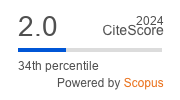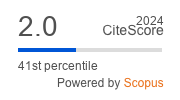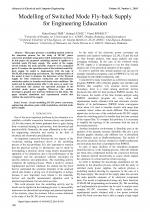| 1/2010 - 18 |
Modelling of Switched Mode Fly-back Supply for Engineering EducationTRIP, N. D. |
| Extra paper information in |
| Click to see author's profile in |
| Download PDF |
Author keywords
circuit modelling, DC-DC power conversion, engineering education, pulse width modulation, switched mode power supply
References keywords
oradea(4), electronics(4), circuits(4)
No common words between the references section and the paper title.
About this article
Date of Publication: 2010-02-27
Volume 10, Issue 1, Year 2010, On page(s): 100 - 105
ISSN: 1582-7445, e-ISSN: 1844-7600
Digital Object Identifier: 10.4316/AECE.2010.01018
Web of Science Accession Number: 000275458900018
SCOPUS ID: 77954661897
Abstract
This paper presents a modelling method useful in the education process for the study of DC-DC power conversion principles using pulse width modulation converters. In this paper, the proposed modelling method is applied to a switched mode Fly-back supply. The model of the supply circuit includes the main parasitic elements of its component parts. To analyze the operation mode of the switched mode Fly-back supply its model is implemented with the help of MATLAB programming environment. The implementation of the model is used to simulate the behaviour of the Fly-back supply for both continuous conduction and discontinuous conduction modes, in transient and steady state conditions. The model and its implementation offer to the users an easier way to understand and analyze the operation principle of the switched mode power supplies. Moreover, the authors developed a graphic user interface dedicated to this study. The paper includes simulation and experimental results that validate the model of the supply. |
| References | | | Cited By |
Web of Science® Times Cited: 1 [View]
View record in Web of Science® [View]
View Related Records® [View]
Updated today
SCOPUS® Times Cited: 0
View record in SCOPUS® [Free preview]
There are no citing papers in the CrossRef Cited-by Linking system.
Disclaimer: All information displayed above was retrieved by using remote connections to respective databases. For the best user experience, we update all data by using background processes, and use caches in order to reduce the load on the servers we retrieve the information from. As we have no control on the availability of the database servers and sometimes the Internet connectivity may be affected, we do not guarantee the information is correct or complete. For the most accurate data, please always consult the database sites directly. Some external links require authentication or an institutional subscription.
Web of Science® is a registered trademark of Clarivate Analytics, Scopus® is a registered trademark of Elsevier B.V., other product names, company names, brand names, trademarks and logos are the property of their respective owners.
Faculty of Electrical Engineering and Computer Science
Stefan cel Mare University of Suceava, Romania
All rights reserved: Advances in Electrical and Computer Engineering is a registered trademark of the Stefan cel Mare University of Suceava. No part of this publication may be reproduced, stored in a retrieval system, photocopied, recorded or archived, without the written permission from the Editor. When authors submit their papers for publication, they agree that the copyright for their article be transferred to the Faculty of Electrical Engineering and Computer Science, Stefan cel Mare University of Suceava, Romania, if and only if the articles are accepted for publication. The copyright covers the exclusive rights to reproduce and distribute the article, including reprints and translations.
Permission for other use: The copyright owner's consent does not extend to copying for general distribution, for promotion, for creating new works, or for resale. Specific written permission must be obtained from the Editor for such copying. Direct linking to files hosted on this website is strictly prohibited.
Disclaimer: Whilst every effort is made by the publishers and editorial board to see that no inaccurate or misleading data, opinions or statements appear in this journal, they wish to make it clear that all information and opinions formulated in the articles, as well as linguistic accuracy, are the sole responsibility of the author.



